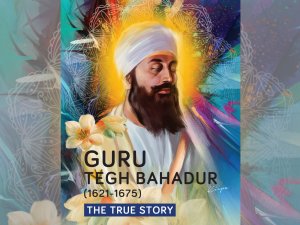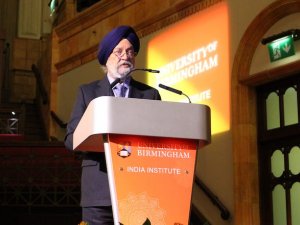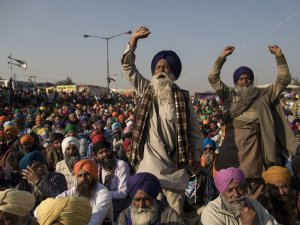Martyrdom (Shaheedi) in Sikhi Tradition
- Self -immolation or suicidal terrorism is not martyrdom
The world is increasingly becoming a dangerous place. The so called Islamic State (IS) claims as its own, the suicide bombers and gunmen going for civilian soft targets. These would-be martyrs have almost unlimited number of ways and means for destroying human lives. The use of a civilian vehicle as a weapon to kill or maim many innocent helpless people is just one recent example..
Misinterpretation of a religious ideology, which also gave birth to Bhagat Farid (sanctified in Sri Guru Granth Sahib) and Saint Mia Mir, hail these suicidal mass murderers as martyrs.
With various claims to martyrdom, ranging from self-immolation to suicidal terrorism, I wonder sometimes if we ourselves understand what is true martyrdom and who is a true martyr in the Sikhi tradition.
Many years ago, I read Sirdar Kapur Singh's Saachi Saakhi. He started with the background to Guru Arjan Dev's martyrdom and concluded with S. Darshan Singh Pheruman's sacrifice (October 1969) for the sanctity of Ardas (Sikh supplication). The background to the latter incident was the so called agan kund (literally "containers for sacrificial fire") erected at Darbar Sahib - a chapter in the history of sacred Sikh martyrdoms, best forgotten.
In 1999, the Pingalwara at Amritsar published an essay by S. Narain Singh with the title, "It is the man and his cause that make him martyr." To quote, "...dying in itself is not a worthy aim to be extolled. Human life is a precious gift of God, not to be thrown off purposelessly."
Recently, I recalled these thoughts in the context of the martyrdom of Guru Tegh Bahadur as I continue to collate evidence from many sources about the life and unique martyrdom of Guru ji. In fact, so far as the underlying principles are concerned, the martyrdoms of Guru Tegh Bahadur and Guru Arjan Dev are the same even though the apparent causes at the time were different.
Martyrdom is a consequence of the struggle between the forces of evil and the invincible warrior for good, who remains unconquered to the end, because, he or she, has already conquered self (is already a mar-jeevra - the reborn). The would-be martyr does not bow to the will of evil but abides by the Will of the Creator Being (Bhana) while remaining true to conscience to the end. The ultimate victory is that of death-defying truthful conduct, justice and the righteous principle being upheld.
Life is given for the cause regardless of the form of torture, but the just cause is not compromised or surrendered.

The lessons taught by the two Guru martyrs, Nanak V, Guru Arjan and Nanak IX, Guru Tegh Bahadur, need to be remembered in the context of the true Sikhi tradition of martyrdom, which is distinct from the earlier Greek and Semitic traditions. Both Guru Sahibaan opposed oppression and bigotry. In both cases, a saintly soul (a pavittar atma) revered by all, led the cause and confronted the evil of bigotry to uphold the principle of religious freedom: own faith (Guru Arjan) and that of another (Guru Tegh Bahadur) - the ultimate martyrdom.
For only the martyrdom of such a person would awaken the spirit of righteous conduct and freedom in the ordinary people. Death was not pre-meditated, but was the inevitable consequence of the struggle (sangharsh) between good and evil.
Inspired by the same fearless spirit, the same cause and dharma (principles), the hundreds who follow such a true martyr also achieve martyrdom. In this regards there are parallels between the Christian and Sikhi traditions. Self-immolation to end own life, or acts of terrorism in which own life and many other innocent lives are lost, cannot be regarded as martyrdom according to the Sikhi tradition.
We meditate daily on the martyrdoms of hundreds of Shaheed Singh-Sighania, because they followed in the footsteps of the Guru Jyot in Guru Arjan and Guru Tegh Bahadur. Either as active warriors with a sword in hand, or as passive captives, they stood rock-firm in their faith for their cause. Death was not premeditated or self-inflicted, but death was a consequence.
They too broke the earthen pitcher (human body), the ttheekar, on the heads of the oppressive tyrants in the same mode as "ttheekar phor Dilhees sir" - as did Guru Tegh Bahadur, cast off his bodily vesture on the head of the emperor of Delhi (to quote Guru Gobind Singh)
As a last resort, the just cause decided by the call of conscience, is regarded as more important than life by the martyr. Death is not pre-meditated but a price which is willingly paid when the time comes. Thus, the oppressor fails to achieve own evil objective and is defeated.
Ultimately, all, no matter how powerful, have to face their own conscience, as did emperor Aurungzeb when reminded of his evil deeds by Guru Gobind Singh in the Zaffarnamah. Such ignoble death can be more painful than the physical demise of a martyr who is already detached from the mortal body and attached to the just cause as dictated by own conscience and dharma (sense of responsibility).
The torture and killing is done by the oppressor while the martyr stands firm without compromising the just cause. These days, there are a variety of claims to martyrdom: by those who threaten to take own life, or by suicidal bombers, or gunmen who kill innocent people, or even by some truck driver who mows down dozens of children, women and old people.
None of these are martyrs according to the Sikhi tradition of martyrdom.
Guru Tegh Bahadur thought deeply about these issues. He reflected on the right leading person to take up the just cause of religious freedom in India? Young Gobind Das had no hesitation in assuring Guru ji that he himself carried Guru Nanak's Jyot and indeed was the true pavittar atma in all India to confront the bigotry of Aurungzeb, so that others would follow in his footsteps.
The struggle between the bigotry of Aurungzeb and the righteous cause taken up by Guru Tegh Bahadur, was one in which Aurungzeb could not win. For, "Whereas the emperor could use the power of the state in support of his policy, the Guru could rely on moral courage inherited from a long line of illustrious predecessors to defend the claims of conscience." (Dr J S Grewal)
Guru Tegh Bahadur's unique martyrdom defeated the designs of Aurungzeb and, eventually, the evil empire collapsed.
We need to tell the world about the true Sikhi ideal of martyrdom as exemplified by Guru Arjan Dev and Guru Tegh Bahadur, as we research and re-discover it ourselves.
Gurmukh Singh OBE
Principal Civil Servant Retired (UK)





